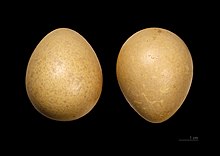Helmet guinea fowl
| Helmet guinea fowl | ||||||||||||
|---|---|---|---|---|---|---|---|---|---|---|---|---|

Helmet guinea fowl in the Kruger National Park . |
||||||||||||
| Systematics | ||||||||||||
|
||||||||||||
| Scientific name of the genus | ||||||||||||
| Numida | ||||||||||||
| Linnaeus , 1766 | ||||||||||||
| Scientific name of the species | ||||||||||||
| Numida meleagris | ||||||||||||
| (Linnaeus, 1758) |
The helmet guinea fowl ( Numida meleagris ) is the best known member of the guinea fowl family , and the only species of the genus Numida . The distribution area is Africa south of the Sahara with the exception of the rainforest areas. It was introduced to Cape Verde and the Caribbean Islands , southwest Arabia, and Madagascar, among others .
Distribution and subspecies
Nine subspecies are currently recognized.
- N. m. sabyi , Morocco .
- N. m. Galeata , West Africa to Chad and Northern Angola .
- N. m. meleagris , Chad to Ethiopia , Uganda and Kenya .
- N. m. somaliensis , Somalia and Northeast Ethiopia.
- N. m. reichowi , Kenya and Tanzania .
- N. m. Mitrata , Tanzania, Mozambique , Zambia , South Angola.
- N. m. marungensis , Congo Basin, Luangwa Basin .
- N. m. damarensis , Southern Angola, Namibia , Botswana .
- N. m. coronata , eastern South Africa .
The domesticated form of the helmet guinea fowl is the house guinea fowl.
features
The helmet guinea fowl reaches a length of 53 to 63 cm and a weight of 1.15 to 1.6 kg. Females stay a little smaller and otherwise resemble roosters. The head and neck are largely featherless, the bare skin is bluish, blue-white and reddish in color. The horn-colored helmet is characteristic and eponymous. The plumage is blackish-gray in color and patterned with numerous white speckles. Chicks have brown downy plumage. The subspecies differ mainly in the extent and color of the featherless skin areas.
Way of life
The helmet guinea fowl prefers warm, dry and open habitats such as forest edges, savannahs , steppes, semi-deserts or agricultural areas. The regional distribution is determined by the water supply. You can often see large gatherings of birds at watering holes. In the mountains you can find the species up to heights of 3000 meters.
Helmet guinea fowl are omnivores, but plant-based food is more important than animal food. They eat seeds, tubers, onions, roots and grain. Animal food, especially insects (mostly termites and grasshoppers ), snails and millipedes make up about 12% of their diet. Ticks are picked up by the warthogs ' wallowing places .
Reproduction
Helmet guinea fowl breed in Morocco from March to May, in West Africa from May to July, in South Africa mainly from November to January. The clutch of the helmet guinea fowl usually comprises 6 to 12 eggs. In exceptional cases, however, there can be 20 to 50 eggs in a nest, perhaps laid by several hens. The eggs are yellowish to pale brown and mottled dark, but sometimes also white. The hen begins to breed as soon as all the eggs are laid. The brood lasts about 24 to 28 days. The young birds reach the weight of the adult birds after 30 weeks.
Danger
The species is common, there are likely to be more than a million birds, and is considered "not endangered". Only the subspecies Numida meleagris sabyi, which lives in a small area of Morocco , may have become extinct. However, there is also the possibility that N. m. sabyi can still be found in the Middle Atlas .
Human and helmet guinea fowl
The helmet guinea fowl is bred in various European regions and has become a fowl. The keeping began in France as early as the 16th century, in Great Britain, the Czech Republic and Germany from the 18th century. The helmeted guinea fowl has also been released since the 18th century and was at least temporarily established in Hungary and Germany. Actions to release domesticated forms, which were still taking place in Baden-Württemberg in the 1950s, were unsuccessful. In the Netherlands there were single pairs between 1998 and 2000, but no breeding records are available for them.
supporting documents
literature
- Josep del Hoyo et al .: Handbook of the Birds of the World. Volume 2: New World Vultures to Guinea Fowl. Lynx Edicions, 1994, ISBN 84-87334-15-6 .
Web links
- Numida meleagris onthe IUCN 2012 Red List of Threatened Species . 2. Listed by: BirdLife International, 2012. Retrieved February 17, 2013.
- Videos, photos and sound recordings of Numida meleagris in the Internet Bird Collection
- Numida meleagris at Fauna Europaea
- Feathers of the helmet guinea fowl
Single receipts
- ↑ Hans-Günther Bauer, Einhard Bezzel and Wolfgang Fiedler (eds.): The compendium of birds in Central Europe: Everything about biology, endangerment and protection. Volume 1: Nonpasseriformes - non-sparrow birds , Aula-Verlag Wiebelsheim, Wiesbaden 2005, ISBN 3-89104-647-2 , p. 147


